Assessing the Economic Value of Carbon Sinks in Farmland Using a Multi-Scenario System Dynamics Model
Abstract
1. Introduction
2. Materials and Methods
2.1. Subsection Study Area and Data
2.2. Methods
2.2.1. Quantifying Carbon Sinks in Farmland
2.2.2. Quantifying the Economic Value of Farmland Carbon Sinks
2.2.3. Analyzing the Influencing Factors on the Economic Value of Farmland Carbon Sinks
- (1)
- Assumption
- (2)
- Building system dynamics model
- (3)
- Setting scenarios
3. Results
3.1. Carbon Sinks in Farmland in Zhejiang from 2007 to 2021
3.2. Economic Value of Farmland Carbon Sinks in Zhejiang from 2007 to 2021
3.3. Change Trends of Carbon Sinks in Farmland and Their Economic Value Under Different Scenarios
3.3.1. Carbon Sinks in Farmland and Their Economic Value Under Business-as-Usual Scenario
3.3.2. Carbon Sinks in Farmland and Their Economic Value Under Policies Scenario
3.3.3. Economic Value of Farmland Carbon Sinks Under Market Scenario
3.3.4. Carbon Sinks in Farmland and Their Economic Value Under Production Management Mode Scenario
4. Discussion
4.1. The Marketization of Carbon Sinks in Farmland System Is a Green Way to Narrow the Urban–Rural Income Gap
4.2. Improving the Production and Management Mode of Farmland Is a Reliable Means to Increase the Carbon Sinks
4.3. Future Perspectives
5. Conclusions
Author Contributions
Funding
Institutional Review Board Statement
Data Availability Statement
Conflicts of Interest
References
- National Bureau of Statistics. China Statistical Yearbook 2022; China Statistics Press: Beijing, China, 2022; pp. 171–174. Available online: https://www.stats.gov.cn/sj/ndsj/2022/indexch.htm (accessed on 10 January 2024).
- Yang, R.; Zhong, C.; Yang, Z.; Wu, Q. Analysis on the Effect of the Targeted Poverty Alleviation Policy on Narrowing the Urban-Rural Income Gap: An Empirical Test Based on 124 Counties in Yunnan Province. Sustainability 2022, 14, 12560. [Google Scholar] [CrossRef]
- Xie, Y.F.; Wu, H.T.; Yao, R.K. The Impact of Climate Change on the Urban-Rural Income Gap in China. Agriculture 2023, 13, 1703. [Google Scholar] [CrossRef]
- Ye, X.; Chuai, X.W. Have rural settlement changes harmed ecosystem carbon in China? Appl. Geogr. 2023, 153, 9. [Google Scholar] [CrossRef]
- Liu, Y.; Gao, Y. Measurement and impactor analysis of agricultural carbon emission performance in Changjiang economic corridor. Alex. Eng. J. 2022, 61, 873–881. [Google Scholar] [CrossRef]
- Malliet, P.; Reynès, F.; Landa, G.; Hamdi-Cherif, M.; Saussay, A. Assessing Short-Term and Long-Term Economic and Environmental Effects of the COVID-19 Crisis in France. Environ. Resour. Econ. 2020, 76, 867. [Google Scholar] [CrossRef]
- Li, Y.L.; Yi, F.J.; Yuan, C.J. Influences of large-scale farming on carbon emissions from cropping: Evidence from China. J. Integr. Agric. 2023, 22, 3209–3219. [Google Scholar] [CrossRef]
- Wu, H.Y.; Tang, J.; Huang, H.J.; Chen, W.K.; Meng, Y. Net Carbon Sequestration Performance of Cropland Use in China’s Principal Grain-Producing Area: An Evaluation and Spatiotemporal Divergence. Land 2021, 10, 714. [Google Scholar] [CrossRef]
- Gao, Y.G.; Wang, M.; Jiang, L.Q.; Zhao, F.; Gao, F.; Zhao, H.Y. Dynamics of carbon budget and meteorological factors of a typical maize ecosystem in Songnen Plain, China. Span. J. Agric. Res. 2023, 21, 4. [Google Scholar] [CrossRef]
- Ke, S.A.; Wu, Y.Q.; Cui, H.Y.; Lu, X.H. The mechanisms and spatial-temporal effects of farmland spatial transition on agricultural carbon emission: Based on 2018 counties in China. Environ. Sci. Pollut. Res. 2023, 30, 107716–107732. [Google Scholar] [CrossRef]
- Hua, L.; Ran, R.; Xie, M.J.; Li, T.R. The capacity of land carbon sinks in poverty-stricken areas in China continues to increase in the process of eradicating extreme poverty: Evidence from a study of poverty-stricken counties on the Qinghai-Tibet Plateau. Environ. Dev. Sustain. 2023, 28, 17253–17280. [Google Scholar] [CrossRef]
- Pan, Y.; Zhang, X.L.; Liu, H.J.; Wu, D.Q.; Dou, X.; Xu, M.Y.; Jiang, Y. Remote sensing inversion of soil organic matter by using the subregion method at the field scale. Precis. Agric. 2022, 23, 1813–1835. [Google Scholar] [CrossRef]
- Holmberg, M.; Junttila, V.; Schulz, T.; Gronroos, J.; Paunu, V.-V.; Savolahti, M.; Minunno, F.; Ojanen, P.; Akujarvi, A.; Karvosenoja, N.; et al. Role of land cover in Finland’s greenhouse gas emissions. Ambio 2023, 52, 1697–1715. [Google Scholar] [CrossRef] [PubMed]
- Chen, Y.; Chen, X.W.; Zheng, P.; Tan, K.M.; Liu, S.Q.; Chen, S.X.; Yang, Z.X.; Wang, X.L. Value compensation of net carbon sequestration alleviates the trend of abandoned farmland: A quantification of paddy field system in China based on perspectives of grain security and carbon neutrality. Ecol. Indic. 2022, 138, 108815. [Google Scholar] [CrossRef]
- Song, S.X.; Kong, M.L.; Su, M.J.; Ma, Y.X. Study on carbon sink of cropland and influencing factors: A multiscale analysis based on geographical weighted regression model. J. Clean. Prod. 2024, 447, 141455. [Google Scholar] [CrossRef]
- Feng, B. Forest Carbon Sink Resource Asset Evaluation with Case Study of Fujian Province in China. Math. Probl. Eng. 2022, 2022, 7391473. [Google Scholar] [CrossRef]
- Bai, Y.; Zhou, Y. The main factors controlling spatial variability of soil organic carbon in a small karst watershed, Guizhou Province, China. Geoderma 2020, 357, 113938. [Google Scholar] [CrossRef]
- Wu, Z.H.; Liu, Y.L.; Han, Y.R.; Zhou, J.A.; Liu, J.M.; Wu, J.A. Mapping farmland soil organic carbon density in plains with combined cropping system extracted from NDVI time-series data. Sci. Total Environ. 2021, 754, 142120. [Google Scholar] [CrossRef]
- Li, Y.Y.; Xue, C.X.; Chai, C.Q.; Li, W.; Li, N.; Yao, S.B. Influencing factors and spatiotemporal heterogeneity of net carbon sink of conservation tillage: Evidence from China. Environ. Sci. Pollut. Res. 2023, 30, 110913–110930. [Google Scholar] [CrossRef]
- Zhang, H.; Zhencheng, O.; Jiang, P.; Li, M.; Zhao, X. Spatial distribution patterns and influencing factors of soil carbon, phosphorus, and C:P ratio on farmlands in southeastern China. Catena 2022, 216, 106409. [Google Scholar] [CrossRef]
- Zhang, W.; Zhang, M.; Wu, S.; Liu, F. A complex path model for low-carbon sustainable development of enterprise based on system dynamics. J. Clean. Prod. 2021, 321, 128934. [Google Scholar] [CrossRef]
- Jiao, J.L.; Pan, Z.T.; Li, J.J. Effect of carbon trading scheme and technological advancement on the decision-making of power battery closed-loop supply chain. Environ. Sci. Pollut. Res. 2023, 30, 14770–14791. [Google Scholar] [CrossRef] [PubMed]
- Li, L.H.; Shi, J.; Liu, H.; Zhang, R.Y.; Guo, C.B. Simulation of Carbon Emission Reduction in Power Construction Projects Using System Dynamics: A Chinese Empirical Study. Buildings 2023, 13, 3117. [Google Scholar] [CrossRef]
- Wang, W.; Zhao, X.-G.; Lu, W.; Hu, S. The sustainable development of a low-carbon system using a system dynamics model: A case study of China. J. Renew. Sustain. Energy 2023, 15, 015902. [Google Scholar] [CrossRef]
- Yu, X.; Tan, Z.; Zhang, Y.; Peng, D.; Xia, H. The Feedback Mechanism of Carbon Emission Reduction in Power Industry of Delayed Systems. Math. Probl. Eng. 2017, 2017, 4163729. [Google Scholar] [CrossRef]
- Deng, X.F.; Chen, X.J.; Ma, W.Z.; Ren, Z.Q.; Zhang, M.H.; Grieneisen, M.L.; Long, W.L.; Ni, Z.H.; Zhan, Y.; Lv, X.N. Baseline map of organic carbon stock in farmland topsoil in East China. Agric. Ecosyst. Environ. 2018, 254, 213–223. [Google Scholar] [CrossRef]
- Li, J.J.; Li, S.W.; Liu, Q.; Ding, J.L. Agricultural carbon emission efficiency evaluation and influencing factors in Zhejiang province, China. Front. Environ. Sci. 2022, 10, 1005251. [Google Scholar] [CrossRef]
- Yang, M.; Hou, Y.R.; Wang, Q.J.Y. Rethinking on regional CO2 allocation in China: A consideration of the carbon sink. Environ. Impact Assess. Rev. 2022, 96, 106822. [Google Scholar] [CrossRef]
- She, W.; Wu, Y.; Huang, H.; Chen, Z.D.; Cui, G.X.; Zheng, H.B.; Guan, C.Y.; Chen, F. Integrative analysis of carbon structure and carbon sink function for major crop production in China’s typical agriculture regions. J. Clean. Prod. 2017, 162, 702–708. [Google Scholar] [CrossRef]
- Huang, H.Q.; Zhou, J. Study on the Spatial and Temporal Differentiation Pattern of Carbon Emission and Carbon Compensation in China’s Provincial Areas. Sustainability 2022, 14, 7627. [Google Scholar] [CrossRef]
- Guo, H.; Xie, S.; Pan, C. The Impact of Planting Industry Structural Changes on Carbon Emissions in the Three Northeast Provinces of China. Int. J. Environ. Res. Public Health 2021, 18, 705. [Google Scholar] [CrossRef]
- Qiao, G.T.; Chen, F.; Wang, N.; Zhang, D.D. Inter-annual variation patterns in the carbon footprint of farmland ecosystems in Guangdong Province, China. Sci. Rep. 2022, 12, 10. [Google Scholar] [CrossRef]
- Xiong, C.; Yang, D.; Huo, J.; Wang, G. Agricultural Net Carbon Effect and Agricultural Carbon Sink Compensation Mechanism in Hotan Prefecture, China. Pol. J. Environ. Stud. 2017, 26, 365–373. [Google Scholar] [CrossRef] [PubMed]
- Huang, X.; Xu, X.; Wang, Q.; Zhang, L.; Gao, X.; Chen, L. Assessment of Agricultural Carbon Emissions and Their Spatiotemporal Changes in China, 1997-2016. Int. J. Environ. Res. Public Health 2019, 16, 3105. [Google Scholar] [CrossRef] [PubMed]
- Song, S.X.; Zhao, S.Y.; Zhang, Y.; Ma, Y.X. Carbon Emissions from Agricultural Inputs in China over the Past Three Decades. Agriculture 2023, 13, 919. [Google Scholar] [CrossRef]
- Zhao, Y.N.; Wang, M.; Lan, T.H.; Xu, Z.H.; Wu, J.S.; Liu, Q.Y.; Peng, J. Distinguishing the effects of land use policies on ecosystem services and their trade-offs based on multi-scenario simulations. Appl. Geogr. 2023, 151, 102864. [Google Scholar] [CrossRef]
- Karami, S.; Karami, E.; Buys, L.; Drogemuller, R. System dynamic simulation: A new method in social impact assessment (SIA). Environ. Impact Assess. Rev. 2017, 62, 25–34. [Google Scholar] [CrossRef]
- Chen, Y.L.; Yu, P.H.; Chen, Y.Y.; Chen, Z.Y. Spatiotemporal dynamics of rice-crayfish field in Mid-China and its socioeconomic benefits on rural revitalisation. Appl. Geogr. 2022, 139, 102636. [Google Scholar] [CrossRef]
- Li, J.; Li, S. Agricultural Subsidies and Land Rental Prices: New Evidence from Meta-analysis. Agric. Commun. 2024, 2, 100051. [Google Scholar] [CrossRef]
- Wang, G.; Feng, Y. Assessment and prediction of net carbon emission from fishery in Liaoning Province based on eco-economic system simulation. J. Clean. Prod. 2023, 419, 138080. [Google Scholar] [CrossRef]
- Jiang, Y.; Koo, W.W. The Short-Term Impact of a Domestic Cap-and-Trade Climate Policy on Local Agriculture: A Policy Simulation with Producer Behavior. Environ. Resour. Econ. 2014, 58, 511–537. [Google Scholar] [CrossRef]
- Reddy, A.A.; Bhagwat, K.D.; Tiwari, V.L.; Kumar, N.; Dixit, G.P. Policies and incentives for promotion of pulses production and consumption: A Review. J. Food Legumes 2023, 36, 209–228. [Google Scholar] [CrossRef]
- Liu, D.H.; Zhang, Z.W.; Liu, Z.H.; Chi, Y. A three-class carbon pool system for normalizing carbon mapping and accounting in coastal areas. Ecol. Indic. 2024, 158, 111537. [Google Scholar] [CrossRef]
- Priori, S.; Barbetti, R.; Meini, L.; Morelli, A.; Zampolli, A.; D’Avino, L. Towards Economic Land Evaluation at the Farm Scale Based on Soil Physical-Hydrological Features and Ecosystem Services. Water 2019, 11, 1527. [Google Scholar] [CrossRef]
- Ji, C.-J.; Hu, Y.-J.; Tang, B.-J.; Qu, S. Price drivers in the carbon emissions trading scheme: Evidence from Chinese emissions trading scheme pilots. J. Clean. Prod. 2021, 278, 123469. [Google Scholar] [CrossRef]
- Deng, Y.; Sarkar, A.; Yu, C.; Lu, Q.; Zhao, M.J.; Das, J.C. Ecological compensation of grain trade within urban, rural areas and provinces in China: A prospect of a carbon transfer mechanism. Environ. Dev. Sustain. 2021, 23, 16688–16712. [Google Scholar] [CrossRef]
- Jiang, J.J.; Xie, D.J.; Ye, B.; Shen, B.; Chen, Z.M. Research on China’s cap-and-trade carbon emission trading scheme: Overview and outlook. Appl. Energy 2016, 178, 902–917. [Google Scholar] [CrossRef]
- Wang, Z.; Wang, C. How carbon offsetting scheme impacts the duopoly output in production and abatement: Analysis in the context of carbon cap-and-trade. J. Clean. Prod. 2015, 103, 715–723. [Google Scholar] [CrossRef]
- Hayatu, N.G.; Liu, Y.R.; Han, T.F.; Daba, N.A.; Zhang, L.; Shen, Z.; Li, J.W.; Muazu, H.; Lamlom, S.F.; Zhang, H.M. Carbon sequestration rate, nitrogen use efficiency and rice yield responses to long-term substitution of chemical fertilizer by organic manure in a rice-rice cropping system. J. Integr. Agric. 2023, 22, 2848–2864. [Google Scholar] [CrossRef]
- Wang, J.; Lu, G.A.; Guo, X.S.; Wang, Y.Q.; Ding, S.W.; Wang, D.Z. Conservation tillage and optimized fertilization reduce winter runoff losses of nitrogen and phosphorus from farmland in the Chaohu Lake region, China. Nutr. Cycl. Agroecosyst. 2015, 101, 93–106. [Google Scholar] [CrossRef]
- Man, M.; Tosi, M.; Dunfield, K.E.; Hooker, D.C.; Simpson, M.J. Tillage management exerts stronger controls on soil microbial community structure and organic matter molecular composition than N fertilization. Agric. Ecosyst. Environ. 2022, 336, 108028. [Google Scholar] [CrossRef]
- Tamburini, G.; De Simone, S.; Sigura, M.; Boscutti, F.; Marini, L. Soil management shapes ecosystem service provision and trade-offs in agricultural landscapes. Proc. R. Soc. B Biol. Sci. 2016, 283, 20161369. [Google Scholar] [CrossRef] [PubMed]
- Jia, L.Z.; Zhao, W.W.; Zhai, R.J.; Liu, Y.; Kang, M.M.; Zhang, X. Regional differences in the soil and water conservation efficiency of conservation tillage in China. Catena 2019, 175, 18–26. [Google Scholar] [CrossRef]
- Teng, C.G.; Lyu, K.; Zhu, M.S.; Zhang, C.S. Impact of Conservation Tillage Technology Application on Farmers’ Technical Efficiency: Evidence from China. Agriculture 2023, 13, 1147. [Google Scholar] [CrossRef]
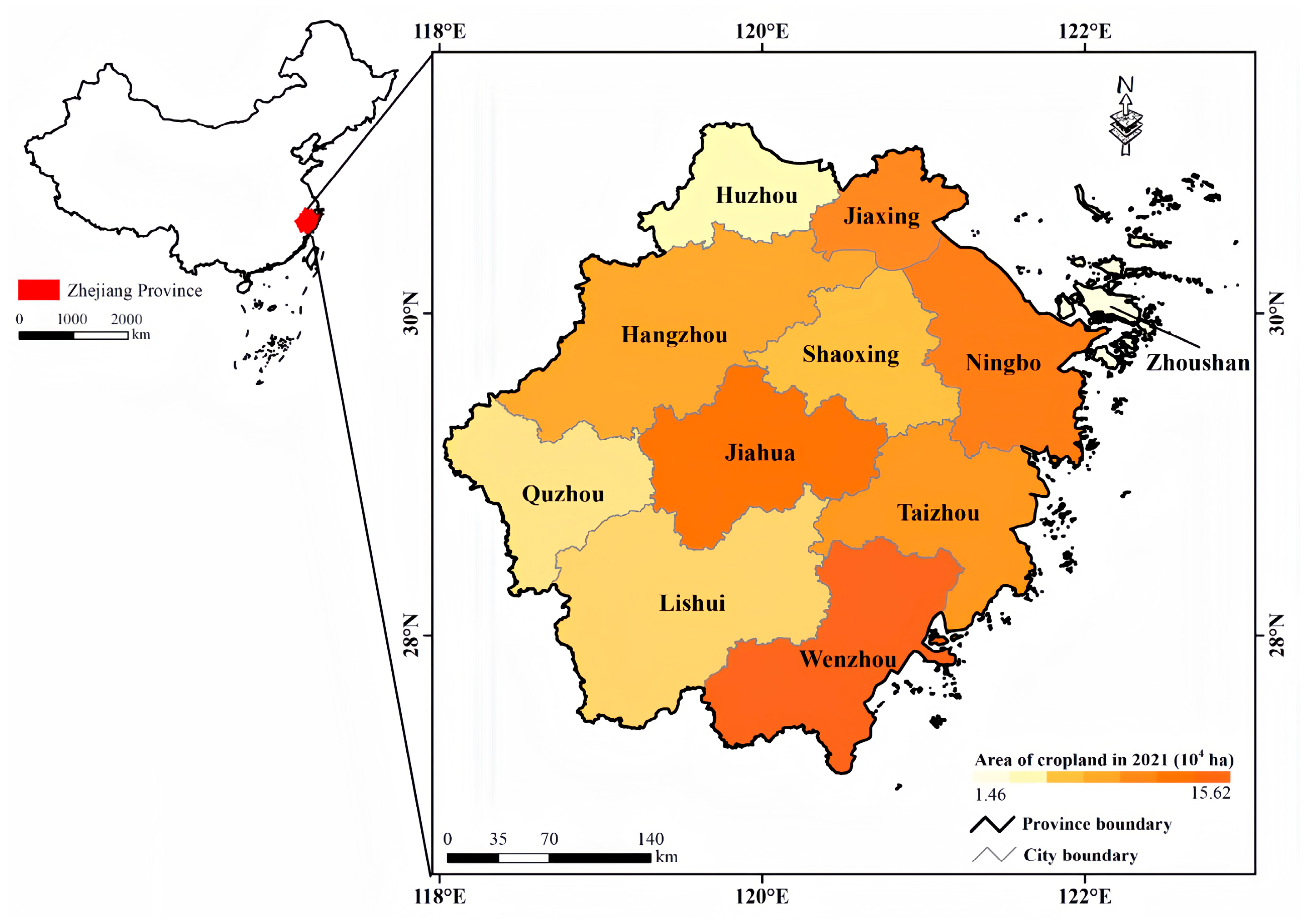
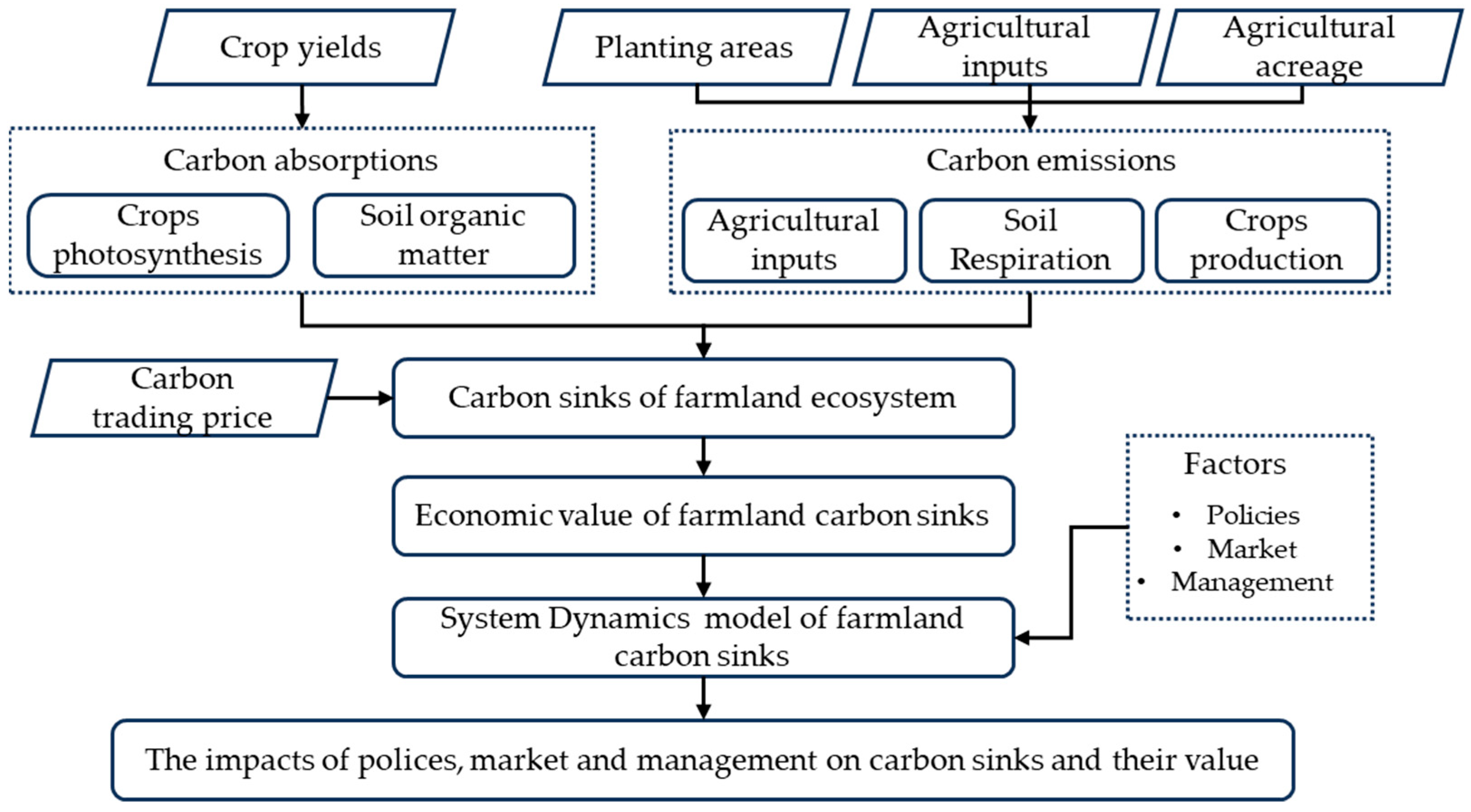
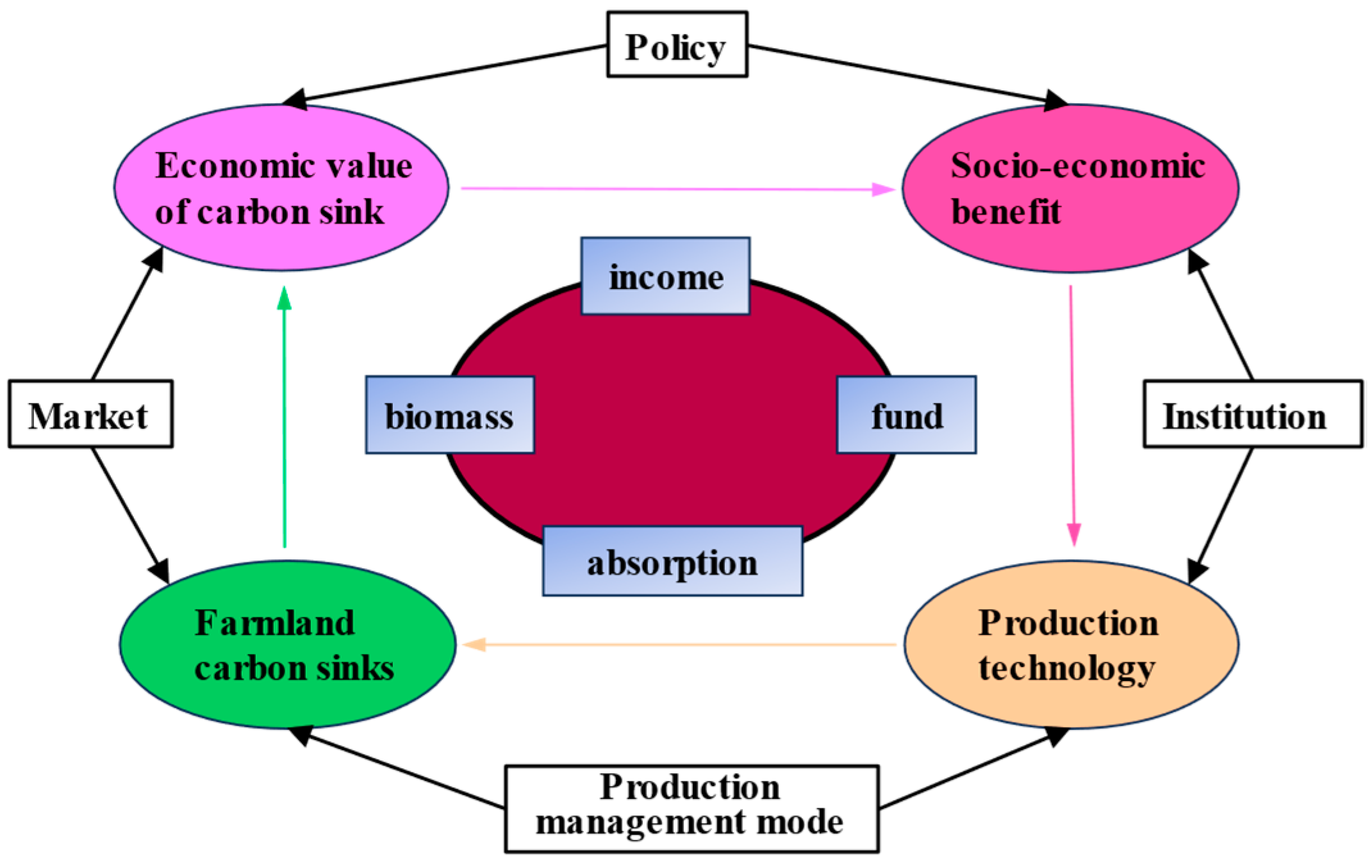
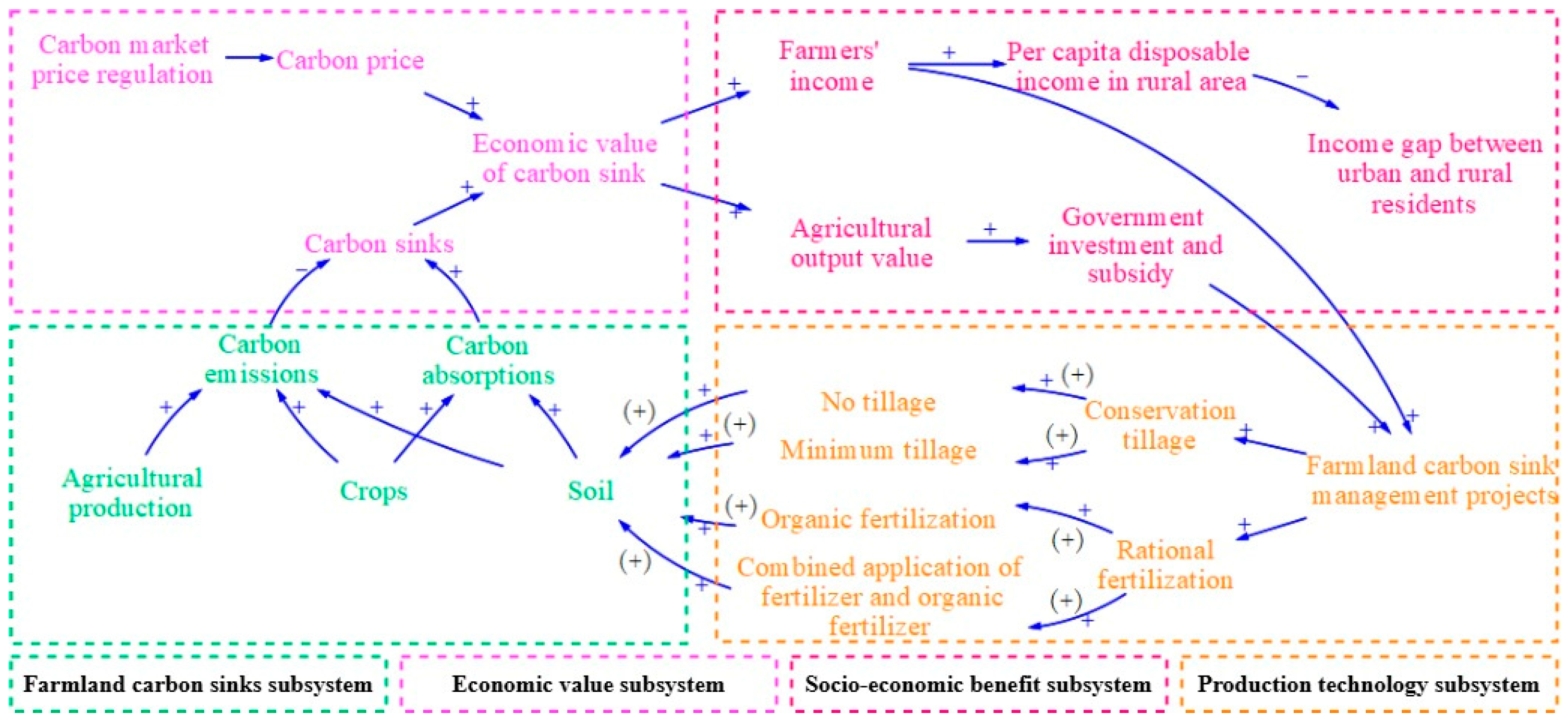
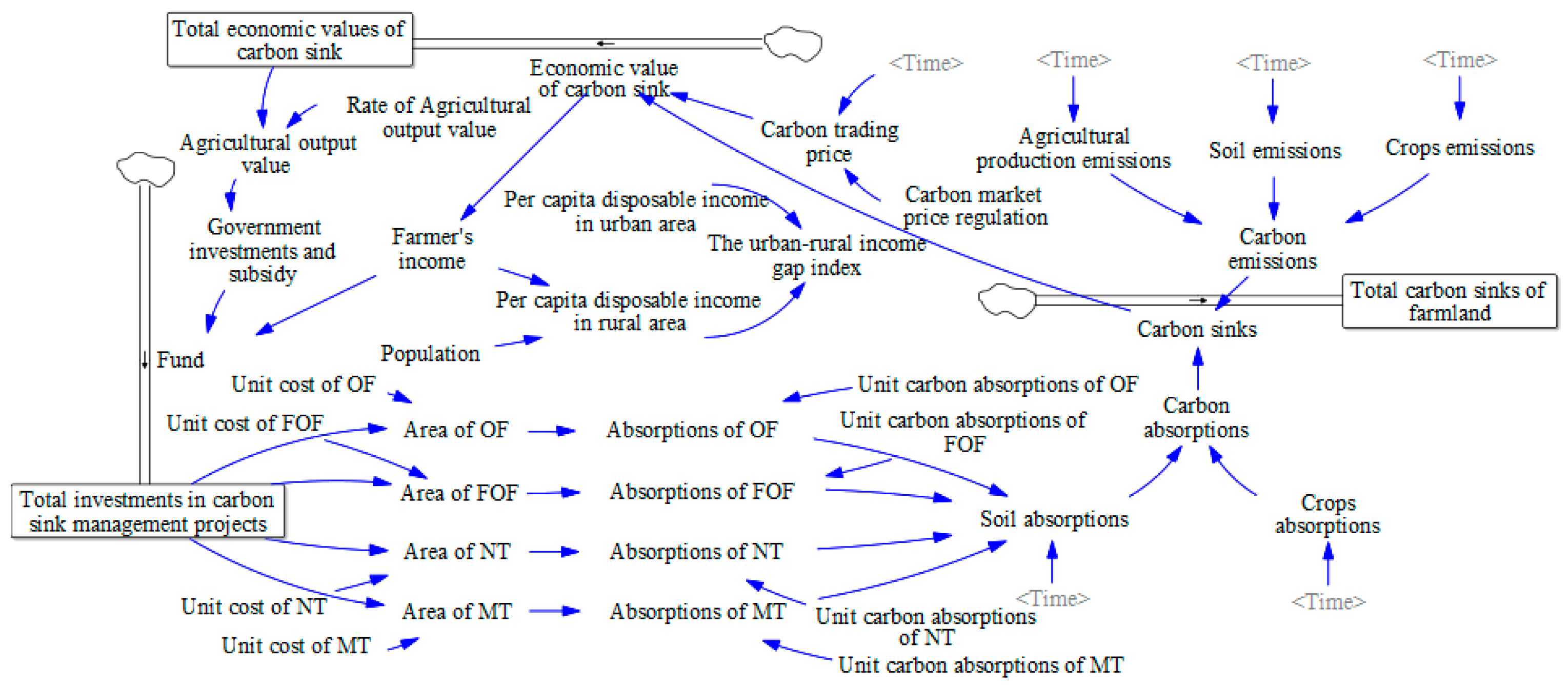
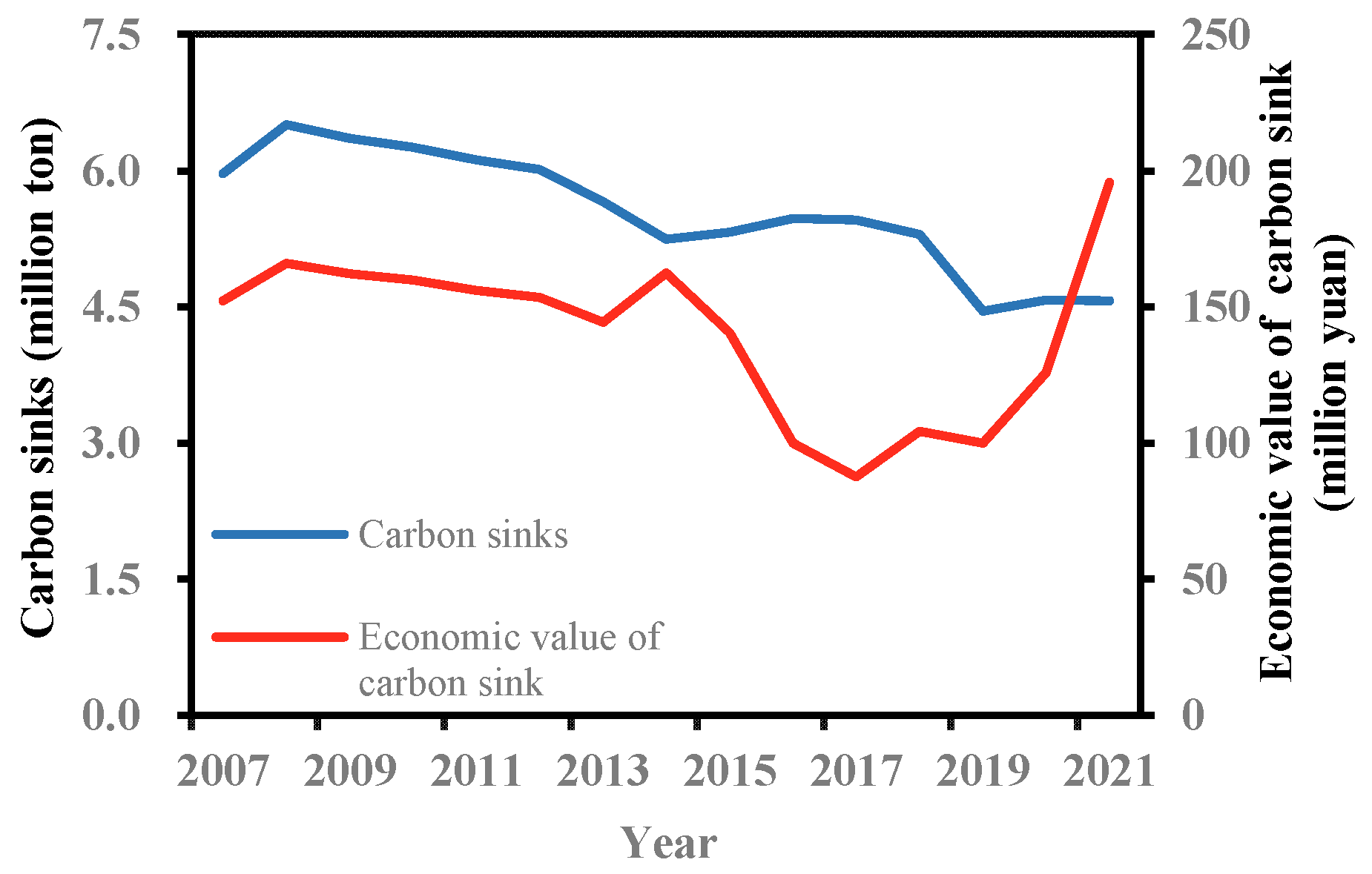
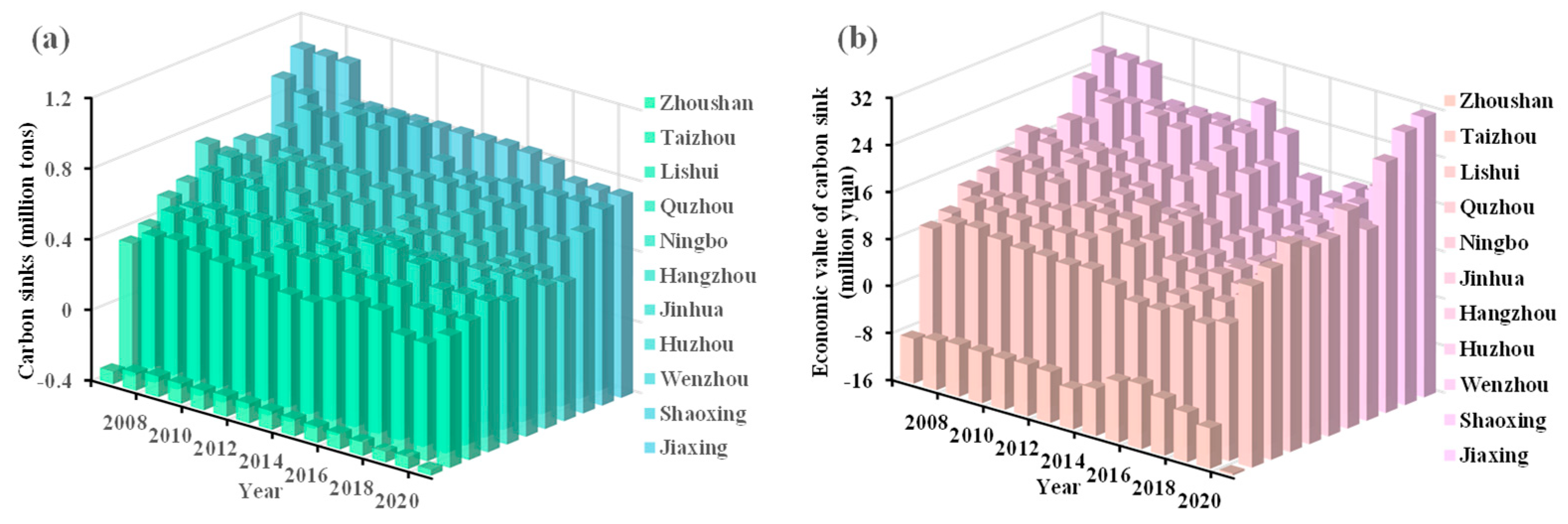


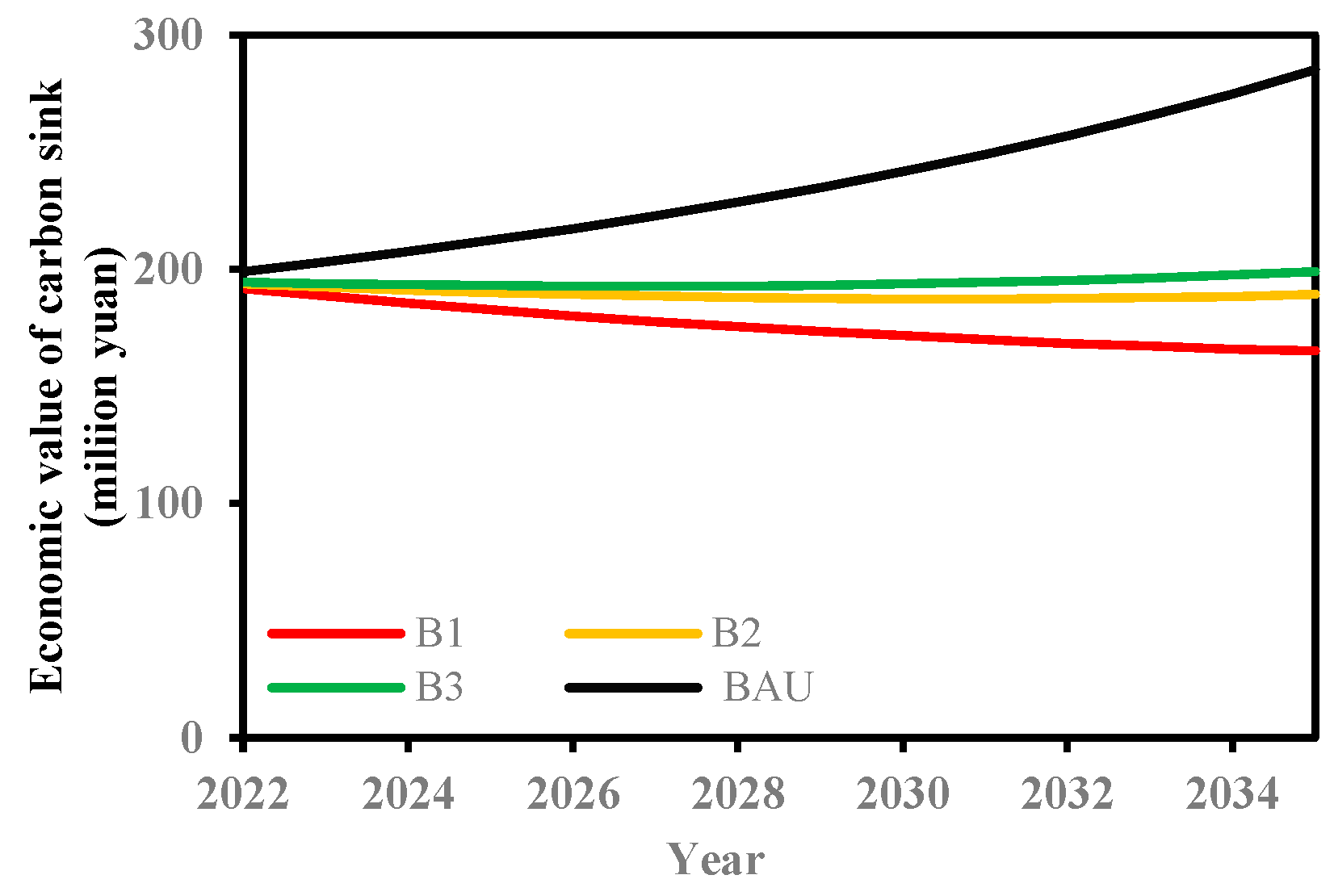
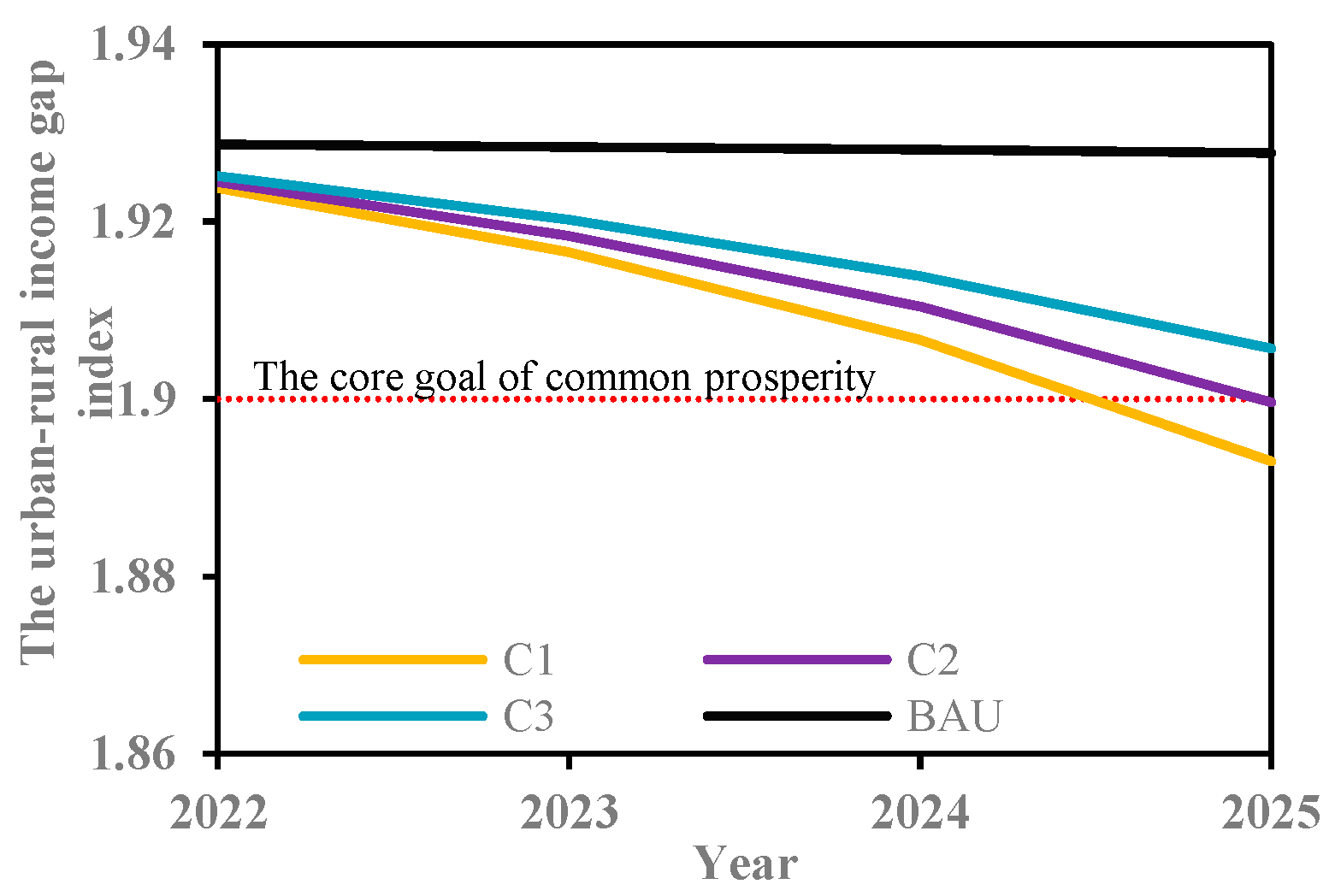


| Category | Data | Source |
|---|---|---|
| Economic and social statistics data | Agricultural inputs, crop-planting areas and yields, agricultural output value, rural population, per capita disposable income in rural and urban areas | Statistical Yearbook (http://tjj.zj.gov.cn/col/col1525563/index.html) accessed on 10 January 2024 |
| Farmland areas | The Third National Land Resource Survey of Zhejiang Province (https://zrzyt.zj.gov.cn/art/2021/12/3/art_1289924_58988385.html) accessed on 10 January 2024 | |
| Carbon trading data | Carbon trading total amount | Carbon Emissions Trading Network (http://www.tanjiaoyi.com) accessed on 10 January 2024 |
| Carbon trading total volume Carbon trading price | ||
| Empirical data of farmland carbon sinks project | Unit cost per hectare | Institute of Environment and Sustainable Development in Agriculture, Chinese Academy of Agricultural Sciences (http://www.ieda.org.cn/index.htm) accessed on 1 January 2024 |
| Unit carbon absorptions per hectare |
| Crop | Carbon Uptake Rate () | Water Content () | Economic Coefficient () |
|---|---|---|---|
| Rice | 0.414 | 0.12 | 0.45 |
| Soybean | 0.450 | 0.13 | 0.34 |
| Vegetables | 0.450 | 0.90 | 0.60 |
| Corn | 0.471 | 0.13 | 0.40 |
| Wheat | 0.485 | 0.12 | 0.40 |
| Carbon Source | Coefficient |
|---|---|
| Fertilizer | 0.8956 kg·kg−1 |
| Pesticide | 4.9341 kg·kg−1 |
| Agricultural plastic film | 5.18 kg·kg−1 |
| Agricultural diesel | 0.5927 kg·kg−1 |
| Irrigation | 25 kg·hm−2 |
| Plowing | 3.126 kg·hm−2 |
| Crops | Emission Coefficient of Greenhouse Gas (kg·hm−2) | Carbon Conversion Coefficient (kg·kg−1) |
|---|---|---|
| Rice | 0.240 | 298.00 |
| Soybean | 0.770 | 298.00 |
| Vegetables | 4.210 | 298.00 |
| Corn | 2.532 | 298.00 |
| Wheat | 1.218 | 298.00 |
| Early rice | 1.437 | 25.00 |
| Late rice | 3.450 | 25.00 |
| Mid-season rice | 5.796 | 25.00 |
| Year | Farmland Carbon Sinks (Million Tons) | Economic Value of Carbon Sink (Million CNY) | ||||
|---|---|---|---|---|---|---|
| Simulation | Observed | Error | Simulation | Observed | Error | |
| 2019 | 4.75 | 4.45 | 6.52% | 109.58 | 99.92 | 9.71% |
| 2020 | 4.65 | 4.58 | 1.70% | 136.45 | 125.86 | 8.51% |
| 2021 | 4.56 | 4.57 | 0.01% | 210.54 | 195.82 | 7.51% |
| Average error | 2.74% | 8.58% | ||||
| Factors | Index | Scenario | Scenario Setting | ||||||
|---|---|---|---|---|---|---|---|---|---|
| Proportion of Government Investment (%) | Proportion of Farmer Input (%) | Carbon Price Change (%) | Proportion of OF (%) | Proportion of FOF (%) | Proportion of NT (%) | Proportion of MT (%) | |||
| Business as Usual | BAU | 15 | 25 | 3.8 | 25 | 25 | 25 | 25 | |
| Policy | Government investment | A1 | 10 | 25 | 3.8 | 25 | 25 | 25 | 25 |
| A2 | 25 | 25 | 3.8 | 25 | 25 | 25 | 25 | ||
| A3 | 40 | 25 | 3.8 | 25 | 25 | 25 | 25 | ||
| Market | Market regulation | B1 | 15 | 25 | 0 | 25 | 25 | 25 | 25 |
| B2 | 15 | 25 | 1 | 25 | 25 | 25 | 25 | ||
| B3 | 15 | 25 | 1.4 | 25 | 25 | 25 | 25 | ||
| Human intervention | C1 | 15 | 25 | 30 | 25 | 25 | 25 | 25 | |
| C2 | 15 | 25 | 32 | 25 | 25 | 25 | 25 | ||
| C3 | 15 | 25 | 35 | 25 | 25 | 25 | 25 | ||
| Production management mode | Farmers’ production factors | D1 | 15 | 20 | 3.8 | 25 | 25 | 25 | 25 |
| D2 | 15 | 40 | 3.8 | 25 | 25 | 25 | 25 | ||
| D3 | 15 | 60 | 3.8 | 25 | 25 | 25 | 25 | ||
| Farmland production means | E1 | 15 | 25 | 3.8 | 50 | 50 | 0 | 0 | |
| E2 | 15 | 25 | 3.8 | 0 | 0 | 50 | 50 | ||
Disclaimer/Publisher’s Note: The statements, opinions and data contained in all publications are solely those of the individual author(s) and contributor(s) and not of MDPI and/or the editor(s). MDPI and/or the editor(s) disclaim responsibility for any injury to people or property resulting from any ideas, methods, instructions or products referred to in the content. |
© 2024 by the authors. Licensee MDPI, Basel, Switzerland. This article is an open access article distributed under the terms and conditions of the Creative Commons Attribution (CC BY) license (https://creativecommons.org/licenses/by/4.0/).
Share and Cite
Song, S.; Su, M.; Kong, L.; Kong, M.; Ma, Y. Assessing the Economic Value of Carbon Sinks in Farmland Using a Multi-Scenario System Dynamics Model. Agriculture 2025, 15, 69. https://doi.org/10.3390/agriculture15010069
Song S, Su M, Kong L, Kong M, Ma Y. Assessing the Economic Value of Carbon Sinks in Farmland Using a Multi-Scenario System Dynamics Model. Agriculture. 2025; 15(1):69. https://doi.org/10.3390/agriculture15010069
Chicago/Turabian StyleSong, Shixiong, Mingjian Su, Lingqiang Kong, Mingli Kong, and Yongxi Ma. 2025. "Assessing the Economic Value of Carbon Sinks in Farmland Using a Multi-Scenario System Dynamics Model" Agriculture 15, no. 1: 69. https://doi.org/10.3390/agriculture15010069
APA StyleSong, S., Su, M., Kong, L., Kong, M., & Ma, Y. (2025). Assessing the Economic Value of Carbon Sinks in Farmland Using a Multi-Scenario System Dynamics Model. Agriculture, 15(1), 69. https://doi.org/10.3390/agriculture15010069






